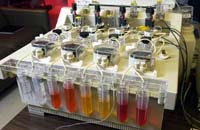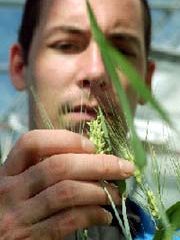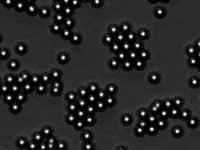Life Sciences and Chemistry
Articles and reports from the Life Sciences and chemistry area deal with applied and basic research into modern biology, chemistry and human medicine.
Valuable information can be found on a range of life sciences fields including bacteriology, biochemistry, bionics, bioinformatics, biophysics, biotechnology, genetics, geobotany, human biology, marine biology, microbiology, molecular biology, cellular biology, zoology, bioinorganic chemistry, microchemistry and environmental chemistry.

Rice centromere, supposedly quiet genetic domain, surprises
Probing the last genomic frontier of higher organisms, an international team of scientists has succeeded in sequencing a little understood – but critical – genetic domain in rice.
In doing so, the group, led by Jiming Jiang, a professor of horticulture at the University of Wisconsin-Madison, and C. Robin Buell of the Institute for Genomic Research in Rockville, Md., has exposed a supposedly barren region of a rice chromosome known as the centromere. The work, published in the current (Jan.

Bacteriophage genomics approach to antimicrobial drug discovery published in Nature Biotechnology
Identifying the targets that bacterial viruses, or phages, use to halt bacterial growth and then screening against those targets for small molecule inhibitors that attack the same targets provides a unique platform for the discovery of novel antibiotics. Researchers from Montreal-based PhageTech, Inc. describe in the February issue of Nature Biotechnology this novel method for discovering new classes of antibiotics. The article is available on-line today at www.nature.com/nbt/.
“Over the co

New device can help defend against novel biological agents
The ability to analyze and defend against novel biological agents has been strengthened by the development of a new device that can monitor the metabolism of living cells in near real time.
“So far we have been lucky that terrorists have used well-known biological agents like anthrax and sarin gas,” says David Cliffel, assistant professor of chemistry at Vanderbilt University, who led the development group working under the auspices of the Vanderbilt Institute for Integrative Biosystems Res

Gene affecting bone mass, osteoporosis risk identified
OHSU, VAMC, Roche scientists use mouse genetics to discover Alox15 gene as potential human therapeutic target
Researchers at Oregon Health & Science University, Portland Veterans Affairs Medical Center and Roche have identified an enzyme affecting skeletal development in mice that may have relevance to human osteoporosis.
The study, titled “Regulation of Bone Mass in Mice by the Lipoxygenase Gene Alox 15,” is published in the Friday, Jan. 9 edition of Science, the journal of

Knowing when to flower
The secret of flowering in our major food crops like wheat has been revealed with the discovery by CSIRO Plant Industry of a gene that triggers flowering in cereals.
“Important cereal crops like wheat and barley rely on the gene we found, WAP1, to initiate flowering,” says Dr Ben Trevaskis, CSIRO Plant Industry.
“Flowering is important because it determines when the plant will produce grain or fruit – the parts we usually eat.”
WAP1 turns ’on’ to activate flowering when

Membrane-coated beads make sensitive assay for protein drug candidates
Microscopic glass beads wearing coats identical to the outer membrane of a cell provide a powerful assay for proteins that bind to cell membranes, such as protein drugs or drug candidates, according to chemists at the University of California, Berkeley, and Lawrence Berkeley National Laboratory (LBNL).
The membrane-coated beads, complete with receptors that dot the surfaces of real cells, also would make a sensitive detection system for viruses or protein toxins like those produced by choler